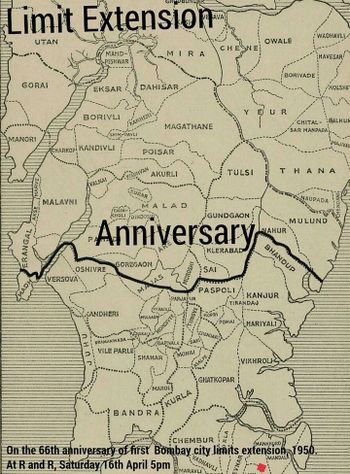Bombay City: Limits and Extensions: Difference between revisions
Created page with "Center" |
No edit summary |
||
| (4 intermediate revisions by the same user not shown) | |||
| Line 1: | Line 1: | ||
[[File:Limit ext 1950.jpg| | [[File:Limit ext 1950.jpg|350px|center]] | ||
On 15th April 1950 the Bombay Municipal (Extension of Limits) Act was brought into force which extended the boundary of Bombay Island city to include areas upto Jogeshwari and Bhandup. These areas earlier constituted Bombay Suburbs and were governed by Borough Municipalities, Notified Area Committees and Village Panchayats which were dissolved and brought under the Municipal Corporation of Bombay. In a dissenting opinion against this Act, Chunilal Barfivala wrote that it was a "wholesale annexation of vast area, abolition of suburban civic units and ruthless sacrifice of the corporate life of the annexed communities" and was designed to "remove all undesirable things to the outskirts of the city", among which are mentioned: manufacturing candles, casting metals, making cow dung cakes, soap making, tar melting, cattle stables, slaughter houses, blood boiling, bone crushing... | |||
These debates, and the reasons given for the limit extension: de-congestion of Bombay, better administration, extending of civic services to Suburbs in exchange for city taxes, and control of crime -- still resonate in present times. | |||
Latest revision as of 17:07, 23 August 2017

On 15th April 1950 the Bombay Municipal (Extension of Limits) Act was brought into force which extended the boundary of Bombay Island city to include areas upto Jogeshwari and Bhandup. These areas earlier constituted Bombay Suburbs and were governed by Borough Municipalities, Notified Area Committees and Village Panchayats which were dissolved and brought under the Municipal Corporation of Bombay. In a dissenting opinion against this Act, Chunilal Barfivala wrote that it was a "wholesale annexation of vast area, abolition of suburban civic units and ruthless sacrifice of the corporate life of the annexed communities" and was designed to "remove all undesirable things to the outskirts of the city", among which are mentioned: manufacturing candles, casting metals, making cow dung cakes, soap making, tar melting, cattle stables, slaughter houses, blood boiling, bone crushing...
These debates, and the reasons given for the limit extension: de-congestion of Bombay, better administration, extending of civic services to Suburbs in exchange for city taxes, and control of crime -- still resonate in present times.
